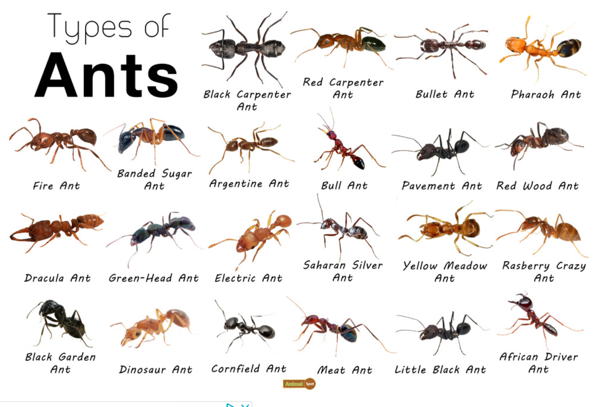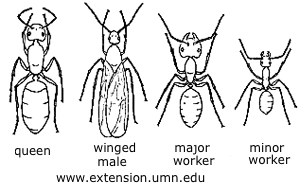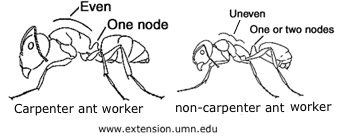 Home & Garden
Home & Garden
 Ant control
Contact
Ant control
Contact
Don's Home
 Home & Garden
Home & Garden
 Ant control
Contact
Ant control
Contact
|

In the United States, there are approximately 700 different ant species. Twenty-five of these species are considered to be household pests.
Controls:
20 Safe Ways to Kill Ants in Your Home Without Toxic Chemicals
How to get rid of ants Naturally
Both of the above mention the use of essential oils, which I have used.
Essential Oil Insect repellant:
96 Oz water, 2 Oz tea tree, 2 oz oz peppermint, 1 oz. citrus
or
1 Qt (32 Oz) water 4 tsp (2/3 OZ) tea tree, 2/3 oz peppermint, 1/3 oz. citrus
Essential Oils That Repel Insects Naturally | Greenix
Purchase a clean spray bottle and fill it with a cup of water, 60 drops (2/3 - 1 teaspoon) of tea tree oil, 60 drops of peppermint oil and 30 drops of the citrus oil of your choice. Shake it well and spray it around areas where ants are common, including baseboards.
Do NOT use this oil in the kitchen or on surfaces where you prepare food. Use a mix of 15 drops peppermint oil and seven drops lemon oil with water to spray food-preparation areas.
Keep concentrated essential oils away from pets, especially cats.
You should not use essential oil diffusers in your house where they can get on the pets skin.
Some places recommend using diluted essential oils on pets to repel insects.
Insecticides are only one of the tools available for control of ants, and not always the best or most important. Ant biology should be considered when deciding whether or not to use insecticides. For example, insecticides are often not effective against mound ants because it often takes foraging ants several days to return to the nests. Consult your regional National Park Service Integrated Pest Management coordinator for information on using pesticides as part of an ant management program.
Ant baits
The best baits for ants are those whose toxicant kills ants slowly. In this way, worker ants live long enough to take the baits back to the nest and feed it to the colony and queen.
 A number of baits are now available. Some are prepackaged in child-resistant bait stations. Some are gels or pastes designed to be placed in small pea-shaped amounts throughout an area. Some products (such as boric acid) are designed to be mixed with a food. Bait products typically will work against certain species of ants but not against others, so it is important to check the label to make sure the ant you wish to control is listed.
A number of baits are now available. Some are prepackaged in child-resistant bait stations. Some are gels or pastes designed to be placed in small pea-shaped amounts throughout an area. Some products (such as boric acid) are designed to be mixed with a food. Bait products typically will work against certain species of ants but not against others, so it is important to check the label to make sure the ant you wish to control is listed.
Most retail products are liquid or granular formulations containing hydramethylnon*, sulfluramid, abamectin, or boric acid.
* Hydramethylnon: tetrahydro-5, 5-dimethyl-2(1H)-pyrimidinone, (3-(4-(trifluoromethyl)
phenyl)-1-(2-(4-(trifluoromethyl) phenyl) ethenyl)-2-propenylidene) hydrazone
Ant baits may not work as well with carpenter ants as the other species mentioned
Insect growth regulators (IGRs)
These are available in bait form for some ant species. Insect growth regulators inhibit normal development of insects. They are slow-acting because they stop the next generation from developing rather than killing the current generation. A recent study comparing the insect growth regulator fenoxycarb to a commercial bait found that the growth regulator was more effective than the bait in eliminating Pharaoh ants. This is most likely because the bait kills ants too quickly to be effectively distributed throughout the colony (Williams and Vail 1994). Crazy ants do not seem to respond well to bait, and baits may be slow-acting against field ants since they often stay away from the nest for several days.
Liquid and aerosol insecticides
Nearly all of the insecticides labeled for use against cockroaches are also labeled for use against ants. These insecticides are most effective when used to treat actual nest sites. Insecticides are less effective, but still may provide acceptable results when used to treat inside cracks and crevices used by ants in and around infested sites. They are least effective, as well as offering the highest potential of human exposure, when they are simply applied to sites where activity has been observed.
Drenches
For certain ground-nesting ants that dig deep nests outdoors, a soil drench or mound drench can be effective where other treatments are not. As its name implies, a soil drench consists of applying enough insecticide dilution directly to a mound or nest so that the entire nest is drenched.
Dusts
Dusts may also be used on occasion for ant control if they are used lightly or directed into nests. In large amounts, dusts tend to repel ants. But they have the advantage of floating back through wall voids to reach nests that may not be accessible with other formulations.
Granules
Granules are rarely used in household ant control. They may be useful, however, when a lawn or field is heavily infested with many colonies of a shallow, ground- nesting species of ant.
Microencapsulated Insecticide
Controlled release technology provides longer-lasting residual control indoors or outdoors.
This type of insecticide will actually deposit microscopic particles of insecticide (invisible to the naked eye) on surfaces where it is sprayed or applied. These tiny "bubbles" of active ingredient are burst when stepped on by or groomed in by the targeted pest.
Micro cap also means the product can be more easily picked up by the tiny hairs on insects and especially flying insects.
See: Insecticide Concentrates at PestProducts.com
Source: Ants at www.greensmiths.com
 Termites are light-colored, have no waist constriction, have straight antennae and, if present, wings are of equal length.
They avoid light and are rarely seen outside of their colony.
Termites are light-colored, have no waist constriction, have straight antennae and, if present, wings are of equal length.
They avoid light and are rarely seen outside of their colony.
Carpenter ant casts:


Carpenter Ants @ U. Minn., says:
Nests are often concealed in wall voids, ceilings, subfloors, attics, or hollow doors. It is usually necessary for a professional pest control applicator to drill small (about 1/8 inch) holes and apply an insecticide into the nest area. It is best to determine the nest's location as specifically as possible. Control should not be applied randomly through the home. There are NO insecticides available to the public that are labeled for this type of application.
Treatments include microencapsulated (time release) or insecticidal dust with ingrediants like benzeneacetate, Cyfluthrin, Diazinon, ....
Some more powerful treatments are available to homeowners in most states at Carpenter Ant Control Products : Pest Products Online.
If it is difficult to locate the nest, an insecticidal dust can be applied into wall voids through electrical outlets. (Note: Some liquid insecticides should NOT be applied in electrical boxes.) Carpenter ants commonly travel along electrical wiring and are likely to encounter the insecticides. This method works more slowly than a direct treatment into the nest. Boric acid is available to home dwellers to treat wall voids through electrical outlets. CAUTION: Use extreme care around electrical wiring and take all necessary steps to avoid accidental electric shocks.
If the nest cannot be located, baits may be an effective alternative.
There are a few baits available to nonprofessionals for carpenter ant control.
See more at the above web site.
Carpenter ants DO NOT eat wood. They remove wood as they create galleries and tunnels.
However, they rarely nest in sound wood, but consistently invade wood that has become wet and started to decay. Carpenter ants are large (about 3/8 to 1/2" long) and black or red.
The best way to control carpenter ants that inhabit a dwelling is to find the nest and destroy it. Insecticide sprays inside the home will kill some of the worker ants, but unless the entire nest is treated, the queen will continue to produce additional members of the colony. Locating a nest can be difficult because nests may be in locations within the walls or roof rafters.
Carpenter ants are most active in the evening hours foraging for all kinds of food, both inside the house and outside. By following ants, you may be able to tell where the nest is. Because carpenter ants keep the tunnelled galleries very clean and push the sawdust and dead insect parts out small holes in the wood, a small, fresh pile of sawdust under the nest timber is the usual sign of an active carpenter ant nest. Once a nest is found, treatment is usually easy with either an insecticide dust or spray. Injection of insecticide into wall voids or the nest itself may be necessary to insure complete control.
To prevent further carpenter ant infestations, trim all trees and bushes so branches do not touch the house and correct moisture problems such as leaky roofs and plumbing. Paint and/or seal exposed wood construction before it becomes wet. Replace previously ant-infested wood, rotted, or water-damaged wooden parts of the structure and eliminate wood/soil contacts. Remove dead stumps on the property and store firewood off the ground and away from the structure.
Carpenter Ant Control and Treatments at CarpenterAnts.com says:
Perimeter treatments - This is the area immediately adjacent to the structure. If you are not treating this area on a regular basis, reconsider. Monthly or quarterly treatments on the outside of your building will get rid of carpenter ants that are foraging and in effect, provide long term carpenter ant control.
Carpernter Ant Prevention and Control | Illinois Department of Public Healty
Other Carpenter Ant Links:
Carpenter Ant Prevention and Control
Carpenter Ant Products:
Inside: carpenter ant gel, Carpenter Ant Gel
Outside: Maxforce Complete granular insect bait is a Hydramethylnon bait product that comes in a 8 oz. container .
Carpenter Ant Control Products : Pest Products Online
Carpenter Ant Products at DoMyOwnPestControl.com
General Ant Products:
Bayer Advanced Home Pest Control - B-Cyfluthrin
Ant Control Products at DoMyOwnPestControl.com
Raid® Ant Killer
Raid Ant & Roach Spray - Imiporthrin 2,5-Dioxo-3 2-propynyl-1-imidazolidinyl methyl 1RS-cis, transchrysanthemate...Cypermethrin cyano 3-phenoxyphenyl methyl 3-2,2-dichloroethenyl-2,2dimethylcyclopropanecarboxylate.
Safety:
WARNING: Be sure to read the labels and take appropriate personal protection precautions when using these products. Some states have restrictions on their use where food is prepared or near child care locations.
Household Products Database - Health and Safety Information on Household Products at the NIH
At JustAnswer.com someone reported their 18 lb. dog ate a Raid and bait,
Links:
Raid Ant & Roach Spray
Ultrasonic repellers don't work and can be safety hazard to humans.
A Vet replied: "He should be fine. The amount of poison in the ant bait is extremely small and even for a dog his size should not cause a problem at all.
The danger is if he ate the packaging since the plastic can cause intestinal problems."
https://donsnotes.com/products/images/ultrasonic-mice.jpg
How to Improve Ant Bait Effectiveness | eHow.com
Ants at www.greensmiths.com
Ant Control at U. Nebr.
Carpenter Ants @ U. Minn
CarpenterAnts.com
Carpenter Ant Control and Treatments
Carpenter Ant Control Products : Pest Products Online
Arrow's Handy Guide to Ants | Arrow Exterminating